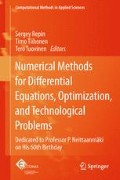Abstract
We study the mathematical modeling and numerical simulation of the motion of red blood cells (RBCs) subject to an external incompressible flow in a microchannel. RBCs are viscoelastic bodies consisting of a deformable elastic membrane enclosing an incompressible fluid. We study two versions of the Finite Element Immersed Boundary Method (FE-IB), a semi-explicit scheme that requires a CFL-type stability condition and a fully implicit scheme that is unconditionally stable and numerically realized by a predictor-corrector continuation strategy featuring an adaptive choice of the time step sizes. The performance of the two schemes is illustrated by numerical simulations for various scenarios including the tank treading motion in microchannels and the motion through thin capillaries.
Access this chapter
Tax calculation will be finalised at checkout
Purchases are for personal use only
References
Abkarian M, Lartigue C, Viallat A (2002) Tank treading and unbinding of deformable vesicles in shear flow: determination of the lift force. Phys Rev Lett 88(6):068103
Anadere I, Chmiel H, Hess H, Thurston GB (1979) Clinical blood rheology. Biorheology 16(3):171–178
Boffi D, Gastaldi L (2003) A finite element approach for the immersed boundary method. Comput Struct 81(8–11):491–501
Boffi D, Gastaldi L, Heltai L (2007) Numerical stability of the finite element immersed boundary method. Math Models Methods Appl Sci 17(10):1479–1505
Brezzi F, Fortin M (1991) Mixed and hybrid finite element methods. Springer, New York
Chien S (1970) Shear dependence of effective cell volume as a determinant of blood viscosity. Science 168:977–979
Chien S (1987) Red cell deformability and its relevance to blood flow. Annu Rev Physiol 49:177–192
Chmiel H, Anadere I, Walitza E (1990) The determination of blood viscoelasticity in clinical hemorheology. Clinical Hemorheology 10:363–374
Cokelet GR (1980) Rheology and hemodynamics. Annu Rev Physiol 42:311–324
Deuflhard P (2004) Newton methods for nonlinear problems. Affine invariance and adaptive algorithms. Springer, Berlin
Eggleton CD, Popel AS (1998) Large deformation of red blood cell ghosts in simple shear flow. Phys Fluids 10:1834–1845
Fischer T, Schmid-Schönbein H (1977) Tank treading motion of red blood cell membranes in viscometric flow: behavior of intracellular and extracellular markers. Blood Cells 3:351–365
Fischer TM, Stöhr-Liesen M, Schmid-Schönbein H (1978) The red cell as a fluid droplet—tank-treading like motion of the human erythrocyte membrane in shear flow. Science 202:894–896
Franke T, Hoppe RHW, Linsenmann C, Schmid L, Willbold C, Wixforth A (2011) Numerical simulation of the motion and deformation of red blood cells and vesicles in microfluidic flows. Comput Vis Sci 14(4):167–180
Hoppe RHW, Linsenmann C (2011) An adaptive Newton continuation strategy for the fully implicit finite element immersed boundary method. Submitted to J Comp Phys
Kantsler V, Steinberg V (2005) Orientation and dynamics of a vesicle in tank-treading motion in shear flow. Phys Rev Lett 95:258101
Keller SR, Skalak R (1982) Motion of a tank-treading ellipsoidal particle in a shear flow. J Fluid Mech 120:27–47
Le DV, White J, Peraire J, Lim KM, Khoo BC (2009) An implicit immersed boundary method for three-dimensional fluid-membrane interactions. J Comput Phys 228(22):8427–8445
Lee P, Griffith BE, Peskin CS (2010) The immersed boundary method for advection-electrodiffusion with implicit timestepping and local mesh refinement. J Comput Phys 229(13):5208–5227
Mori Y, Peskin CS (2008) Implicit second-order immersed boundary methods with boundary mass. Comput Methods Appl Mech Eng 197(25–28):2049–2067
Newren EP, Fogelson AL, Guy RD, Kirby RM (2007) Unconditionally stable discretizations of the immersed boundary equations. J Comp Physiol 222(2):702–719
Noguchi H, Gompper G (2004) Fluid vesicles with viscous membranes in shear flow. Phys Rev Lett 93:258102
Pan T-W, Wang T (2009) Dynamical simulation of red blood cell rheology in microvessels. Int J Numer Anal Model 6(3):455–473
Peskin CS (1977) Numerical analysis of blood flow in the heart. J Comput Phys 25(3):220–252
Peskin CS (2002) The immersed boundary method. Acta Numer 11:479–517
Pozrikidis C (2003) Modeling and simulation of capsules and biological cells. Chapman & Hall/CRC, Boca Raton
Pozrikidis C (2005) Axisymmetric motion of a file of red blood cells through capillaries. Phys Fluids 17(3):031503
Stockie JM, Wetton BR (1999) Analysis of stiffness in the immersed boundary method and implications for time-stepping schemes. J Comput Phys 154(1):41–64
Tartar L (2007) An introduction to Sobolev spaces and interpolation spaces. Springer, Berlin
Thurston GB (1972) Viscoelasticity of human blood. Biophys J 12(9):1205–1217
Thurston GB (1996) Viscoelastic properties of blood and blood analogs. In: How TV (ed) Advances in hemodynamics and hemorheology. JAI Press, London, pp 1–30
Tu C, Peskin CS (1992) Stability and instability in the computation of flows with moving immersed boundaries: a comparison of three methods. SIAM J Sci Stat Comput 13(6):1361–1376
Wang T, Pan T-W, Xing ZW, Glowinski R (2009) Numerical simulation of red blood cell rouleaus in microchannels. Phys Rev E 79(4):041916-1
Acknowledgements
Both authors acknowledge support by the German National Science Foundation DFG within the DFG Priority Program SPP 1253 ‘Optimierung mit partiellen Differentialgleichungen’. The first author has been further supported by the NSF grants DMS-0707602, DMS-0914788, by the BMBF within the projects ‘FROPT’ and ‘MeFreSim’, and by the ESF within the Networking Programme ‘OPTPDE’.
Author information
Authors and Affiliations
Corresponding author
Editor information
Editors and Affiliations
Rights and permissions
Copyright information
© 2013 Springer Science+Business Media Dordrecht
About this chapter
Cite this chapter
Hoppe, R.H.W., Linsenmann, C. (2013). The Finite Element Immersed Boundary Method for the Numerical Simulation of the Motion of Red Blood Cells in Microfluidic Flows. In: Repin, S., Tiihonen, T., Tuovinen, T. (eds) Numerical Methods for Differential Equations, Optimization, and Technological Problems. Computational Methods in Applied Sciences, vol 27. Springer, Dordrecht. https://doi.org/10.1007/978-94-007-5288-7_1
Download citation
DOI: https://doi.org/10.1007/978-94-007-5288-7_1
Publisher Name: Springer, Dordrecht
Print ISBN: 978-94-007-5287-0
Online ISBN: 978-94-007-5288-7
eBook Packages: EngineeringEngineering (R0)

